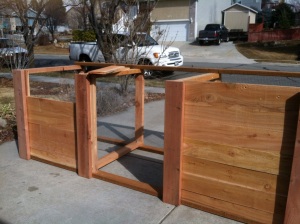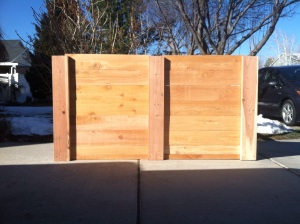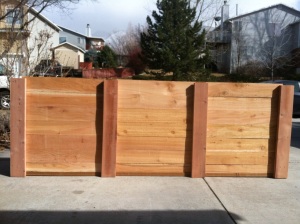Often when I talk to people about composting, they look at me and say that it is too much work or they have tried but had no success. Common themes in the compost failure stories involve the wrong bin, the wrong mixture of ingredients and the failure to turn the compost. Yes composting involves some work. You have to be willing to get outside and get a little dirty along with the exercise of turning the bins. I know I feel a little better after some physical activity. With the right instructions, ingredients and effort I have found the compost process to be very rewarding and kind of addicting. I am constantly saving materials for the compost pile and I often solicit the neighbors for their yard waste.
Lets talk about the wrong bin. People often buy the plastic single bin systems from the home improvement stores. The problem with single bins is that you are regularly mixing new material with old material so how are you ever done with the process and how do you separate the finished compost from the new material? Single bins have no where to turn and mix the compost. Not turning compost causes anaerobic decompensation (no oxygen), which gets slimy and smelly. Mixing the ingredients is the key which aerates the material and helps the mircoorganisms and chemical processes do their magic. With the correct mixture of materials and turning, the compost heats up to the point it is uncomfortable to put your hand in the middle of the pile. This heat (approx 160 degrees), is hot enough to kill pathogens and weed seeds that may be in your raw materials. People who put green compost directly in their soil do not have this advantage of eliminating weeds and pathogens.
Now for the secrets of successful composting. It is not complicated. You need to get yourself a multiple bin system. I use a four bin system but two bin and three bin systems work well based on the amount of materials you have to compost.
You need to have a separate area to keep the raw materials as you need to build the compost pile based on the right ratios. I always stock pile as many leaves as I can get in the fall as in the summer there is a lack of brown material to put in the pile. Layer the materials on a three to one ration (3 parts brown to 1 part green). Keep layering until you fill the first bin (usually on the left), and water each layer but don’t soak. When the bin is full you flip (mix) the material into the next bin. You will be amazed the next day how warm the material has become in the middle in such a short time. Every week you need to mix or turn the material to an empty bin compartment (or in a two bin system open the front and pull the material out and mix it when placing back into the bin). In a three bin system when its time to turn the third bin you can flip the material back to the second bin and then a week later flip it back to the third bin to get five flips for the material. The amount of material shrinks as it decomposes so you will have a little less than half of what you started with at the fourth flip. If you turn your pile five times you will have some compost finished. I get a wheelbarrow and my compost screen and I screen the material into the wheelbarrow. It works better if the material is drier. The material that screens into the wheelbarrow is ready to use. The material that does not go through (with hand scraping on the screen) can just be thrown back into the bin.
I add worms to the bin after the second flip (too hot for them at first). Once you add redworms you will always have them in the bins. My chickens love them and they add fertility to the compost along with the chicken manure that I add to the pile. The worms eat their weight in raw material daily and worm casting are a great fertilizer source.
I mass produce compost in the summer and get hundreds of gallons but I am pretty motivated to keep the process moving. It is easier to list the items not to compost then all the items that work well in compost. Don’t use animal waste, dairy products or meat scraps as they attract rodents and smell. All vegetable scraps, coffee grounds and filters, egg shells, shredded newspaper etc can be used. Wood products break down slower so use sparingly.
This is a quick run down of the process. Hope it helps you be successful composters.










Scott, you make it sound so easy… thank you.